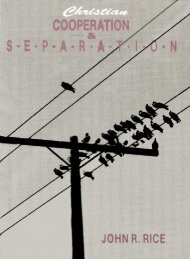The New Presence of China in Africa
Create successful ePaper yourself
Turn your PDF publications into a flip-book with our unique Google optimized e-Paper software.
180 Peter Knorr<strong>in</strong>ga<br />
ist<strong>in</strong>g regulations, laws, conventions and standards), 2. Risk m<strong>in</strong>imization (safeguard<br />
brand-name goodwill and company reputation by mov<strong>in</strong>g beyond mere<br />
compliance) and, 3. Value creation (us<strong>in</strong>g CSR activities as a way to compete and<br />
essentially differentiate oneself from other companies that <strong>of</strong>fer similar products)<br />
(Nelson, 2000: 28). One might argue that “mere” compliance with exist<strong>in</strong>g regulations<br />
should not be seen as a strategic CSR activity. However, there is more to<br />
compliance than <strong>in</strong>itially meets the eye. Regulations are cont<strong>in</strong>uously chang<strong>in</strong>g,<br />
regulations differ by country (and does one take the country <strong>of</strong> consumption or <strong>of</strong><br />
production as po<strong>in</strong>t <strong>of</strong> departure?), and regulations can be adhered to by follow<strong>in</strong>g<br />
either the letter or the spirit <strong>of</strong> the regulation. Moreover, the really significant<br />
improvements <strong>in</strong> the reach <strong>of</strong> responsible production are made through small<br />
improvements that are <strong>in</strong>corporated by large groups <strong>of</strong> companies, and by far<br />
most companies can be situated under the head<strong>in</strong>g <strong>of</strong> “1. Compliance”. <strong>The</strong>refore,<br />
so-called “active” compliance behavior is to be seen as a strategic CSR activity.<br />
<strong>The</strong> three strategic CSR strategies are <strong>of</strong>ten visualized as a pyramid, where<br />
firms aim<strong>in</strong>g for compliance form the large base <strong>of</strong> the pyramid, a smaller group<br />
<strong>of</strong> companies with brand-names aim at risk m<strong>in</strong>imization, and an even smaller<br />
group <strong>of</strong> companies uses their responsible behavior as a key competitive tool.<br />
This categorization ga<strong>in</strong>s a dynamic perspective by add<strong>in</strong>g the Norm Life Cycle<br />
model, a useful tool to analyze the process <strong>of</strong> how new norms can become<br />
ma<strong>in</strong>streamed (F<strong>in</strong>nemore and Sikk<strong>in</strong>k, 1998: 898). 6 <strong>The</strong>y dist<strong>in</strong>guish three stages:<br />
norm emergence, norm cascad<strong>in</strong>g, and norm <strong>in</strong>ternalization, with a key role<br />
assigned to the “norm tipp<strong>in</strong>g” that takes place between the first and second stage<br />
(Segerlund, 2005: 5). In the first stage <strong>of</strong> norm emergence, altruism, empathy,<br />
idealism and commitment are seen as the ma<strong>in</strong> motives for “norm entrepreneurs”<br />
to push, for example, for better labor standards. This refers to the frontrunners<br />
<strong>in</strong> responsible production, <strong>in</strong> particular the various types <strong>of</strong> Fair Trade <strong>in</strong>itiatives.<br />
Moreover, it also <strong>in</strong>cludes those firms that really use their image <strong>of</strong> responsibility<br />
to create value (a well-known example is <strong>The</strong> Body Shop).<br />
Once a certa<strong>in</strong> critical mass <strong>of</strong> key companies have adopted such a norm,<br />
“norm tipp<strong>in</strong>g” br<strong>in</strong>gs us to the second stage <strong>of</strong> norm cascad<strong>in</strong>g <strong>in</strong> which legitimacy,<br />
reputation, and esteem become the ma<strong>in</strong> motives <strong>of</strong> companies to jo<strong>in</strong> what<br />
is now seen as “the right th<strong>in</strong>g to do”. This is also where risk m<strong>in</strong>imization comes<br />
<strong>in</strong>. A-brand companies start see<strong>in</strong>g they need to <strong>in</strong>vest <strong>in</strong> boost<strong>in</strong>g their responsibility<br />
image, <strong>in</strong> order not to “fall beh<strong>in</strong>d” those firms who used to be seen as<br />
frontrunners but are now <strong>in</strong>creas<strong>in</strong>gly sett<strong>in</strong>g the new level <strong>of</strong> expected responsible<br />
behavior.<br />
In the third stage <strong>of</strong> norm <strong>in</strong>ternalization, the new norm has become a generally<br />
accepted m<strong>in</strong>imal standard that all participants need to conform to, and<br />
at this stage, for example, new laws on m<strong>in</strong>imum labor standards can further


















